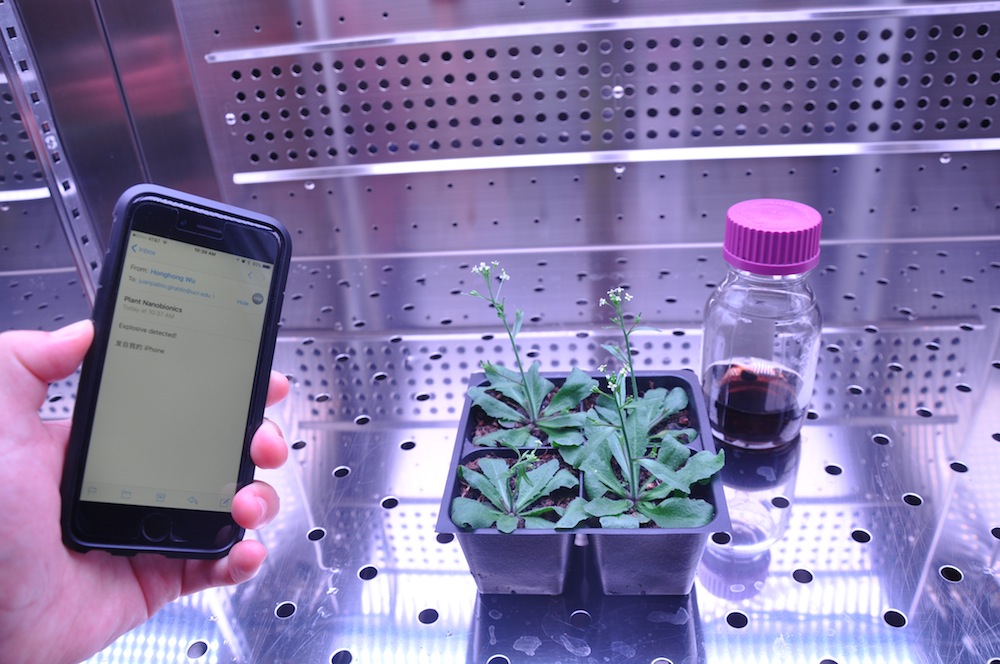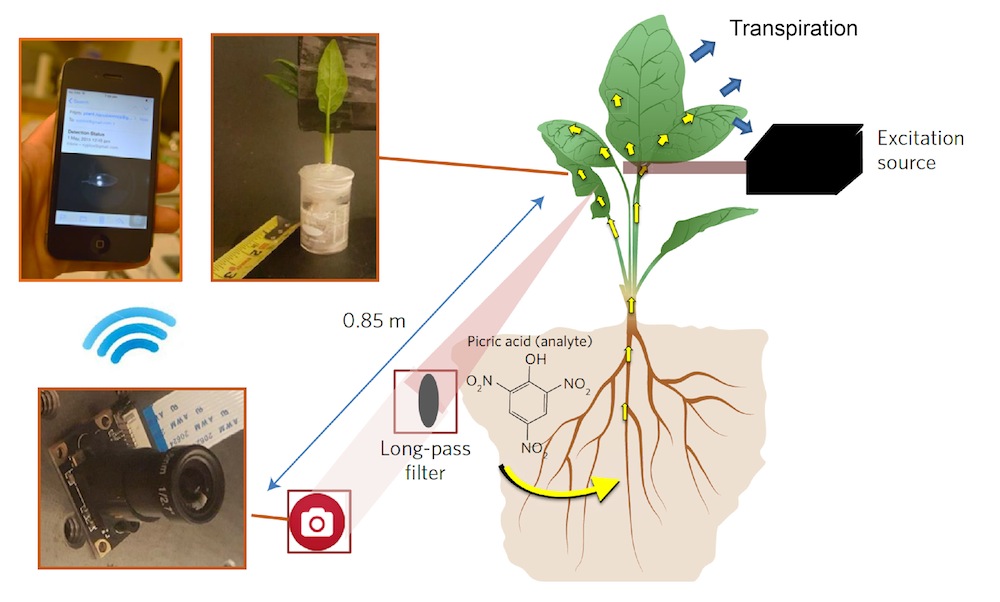
Bionic plants that can detect explosives in real time could be the future of environmental monitoring and urban farming, researchers said in a new study.
The spinach plants have carbon-nanotube-based nanoparticles in their leaves that give off infrared light and are sensitive to the presence of nitroaromatics, key components of several explosives, the scientists said.
If these chemicals are present in groundwater, they are absorbed by the roots and transported to the leaves, where they cause the infrared emissions of the so-called "nanosensor" to decrease. [In Photos: World's Most Polluted Places]
A detector that is similar in complexity to a smartphone can then register this change in emissions, the researchers said. In tests with the nitroaromatic picric acid, this dip was detected within 10 minutes of the roots taking up the chemical, according to the study, published today (Oct. 31) in the journal Nature Materials.
The researchers said their "nanobionic" approach is much faster than previous genetic engineering methods that rely on monitoring changes like wilting or de-greening that can take hours or days and aren't easy to detect electronically. The scientists also used a wild breed of spinach rather than special lab-grown varieties. The researchers said they are confident they can replicate the method with a broad range of plant species that are well-adapted to their environments.
"Genetic engineering is very powerful, but in practice there are only a handful of plants where this can be done. We can take a plant in your backyard and easily engineer it" using nanobionics instead of genetics, said study leader Michael Strano, a professor of chemical engineering at the Massachusetts Institute of Technology (MIT).

Power of plants
Strano said plants make excellent chemical sensors due to the organisms' extensive network of roots and their ability to draw up groundwater using minimal amounts of solar energy. This is thanks to a process known as transpiration, in which moisture evaporates from the leaves, causing water to be drawn up from the roots.
Sign up for the Live Science daily newsletter now
Get the world’s most fascinating discoveries delivered straight to your inbox.
Because the water evaporates, chemicals drawn up along with the fluid that don't easily vaporize get concentrated in the leaves. This means plants can detect very low concentrations of chemicals, the scientists said.
The nanosensor used in the study is sensitive to a broad range of explosives and can even detect chemicals that are produced as explosives degrade, the researchers said.
To pick up the infrared signal, the group used a small infrared camera connected to a $35 Raspberry Pi minicomputer, but Strano told Live Science that a smartphone could be easily adapted to the job if its infrared filter was removed.
Testing of the system was carried out at a distance of about 3.3 feet (1 meter), but Strano said the sensor should be capable of a much wider range, which would allow one sensor to monitor multiple plants. This is because a second fluorescent nanoparticle added along with the nanosensor is not sensitive to nitroaromatics, and so provides a constant reference infrared signal to compare against what's being picked up by the nanosensor.
"What we are interested in doing is showing we can make a really robust human-plant interface," Strano said. "The reference signal means you can intercept this IR signal from any angle, at any distance accurately and quickly." [Top 10 Craziest Environmental Ideas]
Important step
Bogdan Dragnea, a professor of chemistry at Indiana University who specializes in nanotechnology but wasn't involved with the new study, said the work marks an exciting step toward better monitoring of soil contamination.
"A potential caveat is related to possible clearance, and/or biofouling of the transducer by the plant, and the possibility of false positives, but presumably such issues will be addressed further along the road," Dragnea told Live Science.
Strano said his group hopes to increase the number of sensors that can be applied to plants so the instruments can detect a variety of chemicals in both the air and groundwater. He said he also wants to use nanotechnology to give plants the ability to react to these signals in ways not found in nature.
"A plant can monitor its own environment for pest infestations, damage, drought," Strano said. "They're very sensitive readers of their own physiology, and we're interested in extending this approach and tapping into plants' own complex signaling pathways."
Strano and the paper's lead author, MIT graduate student Min Hao Wong, have started a company called Plantea to look into how to commercialize the technology. Strano said he thinks urban farming is a promising market because these farms need to be ultra-efficient to make the best use of expensive land. Plus, the plants would be in an enclosed space, making them easier to monitor, he added.
Raffaele Di Giacomo, a postdoctoral scholar at ETH Zurich in Switzerland, who also works on nanobionics but was not involved with this study, said the approach may encounter some difficulties with calibration and stability, but the system's simplicity and low cost should compensate for this.
"I don't doubt that in the near future we will have commercial sensing plants in our home or offices that will send us directly on our smartphone data about temperature, humidity, oxygen and pollutants," he told Live Science.
Original article on Live Science.











